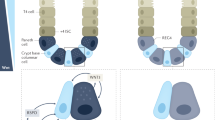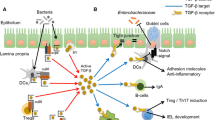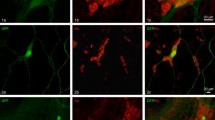Abstract
Background
Local expression of anti-inflammatory or immunoregulatory genes may offer an alternative treatment of gastrointestinal inflammation.
Discussion
We review the basic requirements for gene therapy, the possible routes of delivery, and the different strategies for specific targeting focusing on gastrointestinal inflammation.



Similar content being viewed by others
References
Pawel BR, de Chadarevian JP, Franco ME (1997) The pathology of fibrosing colonopathy of cystic fibrosis: a study of 12 cases and review of the literature. Hum Pathol 28:395–399
Cummings OW (2000) Pathology of the adenoma-carcinoma sequence: from aberrant crypt focus to invasive carcinoma. Semin Gastrointest Dis 11:229–237
Granger DN, Korthuis RJ (1995) Physiologic mechanisms of postischemic tissue injury. Annu Rev Phys 57:311–332
MacNaughton WK (2000) Review article: new insights into the pathogenesis of radiation-induced intestinal dysfunction. Aliment Pharmacol Ther 14:523–528
Jankowski JA (2000) Barret's metaplasia. Lancet 356:2079–2085
Sollid LM (2000) Molecular basis of celiac disease. Annu Rev Immunol 18:53–81
Schuppan D (2000) Current concepts of celiac disease pathogenesis. Gastroenterology 119:234–242
Heneghan MA, Moran AP (2001) Helicobacter pyroli, Lewis antigens, and inflammation. Gut 48:869
Anderson WF (1998) Human gene therapy. Nature 392:25–30
Hedley ML (2000) Gene therapy of chronic inflammatory disease. Adv Drug Deliv Rev 44:195–207
Young LS, Mautner V (2001) The promise and potential hazards of adenovirus gene therapy. Gut 48:733–736
Rennick DM, Fort MM (2000) Lessons from genetically engineered animal models-XII. IL-10-deficient (IL-10 (–/–)) mice and intestinal inflammation. Am J Physiol Gastrointest Liver Physioly 278:G829–G833
Deventer SJH van, Elson CO, Fedorak RN, Group CsDS (1997) Multiple doses of intravenous interleukin 10 in steroid-refractory Crohn's disease. Gastroenterology 113:383–389
Montfrans C van, et al (2002) Treatment of Crohn's disease with recombinant human interleukin 10 induces the proinflammatory cytokine interferon γ. Gut 50:191–195
Miller DG, Adam MA, Miller AD (1990) Gene transfer by retrovirus vectors occurs only in cells that are actively replicating at the time of infection. Mol Cell Biol 10:4239–4342
Halene S, Kohn DB (2000) Gene therapy using hematopoietic stem cells: Sisyphus approaches the crest. Hum Gene Ther 11:1259–1267
Bukrinsky MI, Haffar OK (1999) HIV-1 nuclear import: in search of a leader. Front Biosci 4:D772–D781
Zennou V, Petit C, Guetard D, Nerhbass U, Montagnier L, Charneau P (2000) HIV-1 genome nuclear import is mediated by a central DNA flap. Cell 101:173–185
Russell WC (2000) Update an adenovirus and its vectors. J Gen Virol 81:2573–2604
Walther W, Stein U (2000) Viral vectors for gene transfer—a review of their use in the treatment of human diseases. Drugs 60:249–271
Kay MA, Glorioso JC, Naldini L (2001) Viral vectors for gene therapy: the art of turning infectious agents into vehicles of therapeutics. Nat Med 7:33–40
Marshall E (2002) Clinical research: gene therapy a suspect in leukemia-like disease. Science 298:34–35
Powell SK, Kaloss M, Burimski I, Weaver L, Long Z, Lyons R, McGarrity GJ, Otto E (1999) In vitro analysis of transformation potential associated with retroviral vector insertions. Hum Gene Ther 10:2123–2132
Amado RG, Chen IS (1999) Lentiviral vectors-the promise of gene therapy within reach? Science 285:674–676
Federico M (1999) Lentiviruses as gene delivery vectors. Curr Opin Biotechnol 10:448–453
Verma IM, Somia N (1997) Gene therapy—promises, problems and prospects. Nature 389:239–242
Reiser J (2000) Production and concentration of pseudotyped HIV-1-based gene transfer vectors. Gene Ther 7:910–913
Vigna E, Naldini L (2000) Lentiviral vectors: excellent tools for experimental gene transfer and promising candidates for gene therapy. J Gene Med 2:308–316
Trono D (2000) Lentiviral vectors: turning a deadly foe into a therapeutic agent. Gene Ther 7:20–23
Seppen J, Barry SC, Klinkspoor JH, Katen LJ, Lee SP, Garcia JV, Osborne WR (2000) Apical gene transfer into quiescent human and canine polarized intestinal epithelial cells by lentivirus vectors. J Virol 74:7642–7645
Cheng DY, Kolls JK, Lei D, Noel RA (1997) In vivo and in vitro gene transfer and expression in rat intestinal epithelial cells by E1-deleted adenoviral vector. Hum Gene Ther 8:755–764
Lindsay JO, Ciesielski CJ, Feldmann M, Brennan FM (2000) The stable infection of epithelial cell lines and primary rabbit colon cells with an adenovirus encoding murine interleukin-10 (mIL-10) generates bioactive cytokine at therapeutic concentrations. Gastroenterology a 3035
Lindsay J, van Montfrans C, Brennan F, van Deventer S, Drillenburg P, Hodgson H, te Velde A, MS RP (2002) IL-10 gene therapy prevents TNBS induced colitis. Gene Ther 9:1715–1721
Kitani A, Fuss IJ, Nakamura K, Schwartz OM, Usui T, Strober W (2000) Treatment of experimental (trinitrobenzene sulfonic acid) colitis by intranasal administration of transforming growth factor (TGF)-beta1 plasmid: TGF-beta1-mediated suppression of T helper cell type 1 response occurs by interleukin (IL)-10 induction and IL-12 receptor beta2 chain downregulation. J Exp Med 192:41–52
During MJ, Xu R, Young D, Kaplitt MG, Sherwin RS, Leone P (1998) Peroral gene therapy of lactose intolerance using an adeno-associated virus vector. Nat Med 4:1131–1135
Lindsay JO, Cathleen J, Ciesielski FMB, Humphrey J, Hodgson (2001) Rectal administration of an adenoviral vector encoding IL-10 induces colonic IL-10 release with minimal anti-adenoviral response. Gastroenterology a 3715
Rogy MA, Beinhauer BG, Reinisch W, Huang L, Pokieser P (2000) Transfer of interleukin-4 and interleukin-10 in patients with severe inflammatory bowel disease of the rectum. Hum Gene Ther 11:1731–1741
Ayuk FA, Li Z, Kuhlcke K, Lindemann C, Schade UM, Eckert HG, Zander AR, Fehse B (1999) Establishment of an optimised gene transfer protocol for human primary T lymphocytes according to clinical requirements. Gene Ther 6:1788–1792
Movassagh M, Boyer O, Burland M, Leclercq L, Klatzmann D, and Lemoine FM (2000) Retrovirus-mediated gene transfer into T cells: 95% transduction efficiency without further in vitro selection. Hum Gene Ther 11:1189–1200
Dardalhon V, Jaleco S, Rebouissou C, Ferrand C, Skander N, Swainson L, Tiberghirn P, Spits H, Noraz N, Taylor N (2000) Highly efficient gene tranfer in naive human T cells with a murine leukemia virus-based vector. Blood 96:885–893
Blaese RM, Culver KW, Miller AD, Carter CS, Fleisher T, Clerici M, Shearer G, Chang L, Chiang Y, Tolstoshev P (1995) T lymphocyte-directed gene therapy for ADA-SCID: initial trial results after 4 years. Science 270:475–480
Anderson WF (2000) Gene therapy. The best of times, the worst of times. Science 288:627–629
Cavazzano-Calvo M, Hacein-Bey S, de Saint Basile G, Gross G, Yvon E, Nusbaum P, Selz F, Hue C, Certain S, Casanova JL, Bousso P, Le Deist F, Fischer A (2000) Gene therapy of human severe combined immunodeficiency (SCID)-X1 disease. Science 288:669–672
Bonini C, Ferrari G, Verzeletti S, Servida P, Zappone E, Ruggieri L, Ponzoni M, Rossini S, Mavilio F, Traversari C, Bordignon C (1997) HSV-TK gene transfer into donor lymphocytes for control of allogeneic graft-versus-leukemia. Science 276:1719–1724
Chen LZ, Hochwald GM, Huang C, Dakin G, Tao H, Cheng C, Simmons WJ, Dranoff G, Thorbecke GJ (1998) Gene therapy in allergic encephalomyelitis using myelin basic protein-specific T cells engineered to express latent transforming growth factor-beta1. Proc Natl Acad Sci U S A 95:12516–12521
Setoguchi K, Misaki Y, Araki Y, Fujio K, Kawahata K, Kitamura T, Yamamoto K (2000) Antigen-specific T cells transduced with IL-10 ameliorate experimentally induced arthritis without impairing the systemic immune response to the antigen. J Immunol 165:5980–5986
van Montfrans C, Hooijberg E, Rodriguez-Pena M, de Jong E, Spits H, te Velde A, van Deventer S (2002) Generation of regulatory gut-homing human T lymphocytes using ex vivo interleukin 10 gene transfer. Gastroenterology 123:1877–1888
Montfrans C van, Rodriguez-Pena M, Pronk I, ten Kate F, te Velde A, van Deventer S (2002) Prevention of colitis by interleukin 10-transduced T lymphocytes in the SCID mice transfer model. Gastroenterology 123:1865–1876
Timmerman JM, Levy R (1999) Dendritic cell vaccines for cancer immunotherapy. Annu Rev Med 50:507–529
Bonini C, Lee SP, Riddell SR, Greenberg PD (2001) Targeting antigen in mature dendritic cells for simultaneous stimulation of CD4+ and CD8+ T cells. J Immunol 166:5250–5257
Legge KL, Gregg RK, Maldonado-Lopez R, Li L, Caprio JC, Moser M, Zaghouani H (2002) On the role of dendritic cells in peripheral T cell tolerance and modulation of autoimmunity. J Exp Med 196:217–227
Lipscomb MF, Masten BJ (2002) Dendritic cells: immune regulators in health and disease. Physiol Rev 82:97–130
Feili-Hariri M, Dong X, Alber S, Watkins S, Salter R, Morel P (1999) Immunotherapy of NOD mice with bone marrow-derived dendritic cells. Diabetes 48:2300–2308
Khoury S, Gallon L, Chen W, Betres K, Russell M, Hancock W, Carpenter C, Sayegh M, Weiner H (1995) Mechanisms of acquired thymic tolerance in experimental autoimmune encephalomyelitis: thymic dendritic-enriched cells induce specific peripheral T cell unresponsiveness in vivo. J Exp Med 182:357–366
Vile RG, Sunassee K, Diaz RM (1998) Strategies for achieving multiple layers of selectivity in gene therapy. Mol Med Today 4: 84–92
Peng KW (1999) Strategies for targeting therapeutic gene delivery. Mol Med Today 5:448–453
Peng KW, Russell SJ (1999) Viral vector targeting. Curr Opin Biotechnol 10:454–457
Sweetser DA, Birkenmeier EH, Hoppe PC, McKeel DW, Gordon JI (1988) Mechanisms underlying generation of gradients in gene expression within the intestine: an analysis using transgenic mice containing fatty acid binding protein-human growth hormone fusion genes. Genes Dev 2:1318–1332
Marin M, Noel D, Piechaczyk M (1997) Towards efficient cell targeting by recombinant retroviruses. Mol Med Today 3:396–403
Sommerfelt M (1999) Retrovirus receptors. J Gen Virol 80:3049–3064
Gallardo H, Tan C, Ory D, Sadelain M (1997) Recombinant retroviruses pseudotyped with the vesicular stomatitis virus G glycoprotein mediate both stable gene transfer and pseudotransduction in human peripheral blood lymphocytes. Blood 90:952–957
Lodge R, Subbramanian RA, Forget J, Lemay G, Cohen EA (1998) MuLV-based vectors pseudotyped with truncated HIV glycoproteins mediate specific gene transfer in CD4+ peripheral blood lymphocytes. Gene Ther 5:655–664
Hanauer SB, Dassopoulos T (2001) Evolving treatment strategies for inflammatory bowel disease. Annu Rev Med 52:299–318
Ghosh S, May MJ, Kopp EB (1998) NFkB and rel proteins: evolutionarily conserved mediators of immune response. Annu Rev Immunol 16:225–260
Makarov SS (2000) NF-kappaB as a therapeutic target in chronic inflammation: recent advances. Mol Med Today 6:441–448
Tak PP, Firestein GS (2001) NF-kappaB: a key role in inflammatory diseases. J Clin Invest 107:7–11
Nelms K, Keegan AD, Zamorano J, Ryan JJ, Paul WE (1999) The IL-4 receptor: signaling mechanisms and biologic functions. Annu Rev Immunol 17:701–738
Moore KW, de Waal Malefyt R, Coffman RL, O'Garra A (2001) Interleukin-10 and the interleukin-10 receptor. Annu Rev Immunol 19:683–765
Arend WP, Malyak M, Guthridge CJ, Gabay C (1998) Interleukin-1 receptor antagonist: role in biology. Annu Rev Immunol 16:27–55
Wallach D, Varfolomeev EE, Malinin NL, Goltsev YV, Kovalenko AV, Boldin MP (1999) Tumor necrosis factor receptor and Fas signaling mechanisms. Annu Rev Immunol 17:331–367
Hasko G, Szabo C (1999) IL-12 as a therapeutic target for pharmacological modulation in immune-mediated and inflammatory diseases: regulation of T helper 1/T helper 2 responses. Br J Pharmacol 127:1295–1304
Coyle AJ, Gutierrez-Ramos JC (2001) The expanding B7 superfamily: increasing complexity in costimulatory signals regulating T cell function. Nat Immunol 2:203–209
Foy TM, Aruffo A, Bajorath J, Buhlmann JE, Noelle RJ (1996) Immune regulation by CD40 and its ligand GP39. Annu Rev Immunol 14:591–617
Siegel RM, Chan FK, Chun HJ, Lenardo MJ (2000) The multifaceted role of Fas signaling in immune cell homeostasis and autoimmunity. Nat Immunol 1:469–474
Author information
Authors and Affiliations
Corresponding author
Rights and permissions
About this article
Cite this article
van Montfrans, C., te Velde, A.A., van Deventer, S.J.H. et al. Gene therapy in the treatment of intestinal inflammation. Int J Colorectal Dis 19, 79–86 (2004). https://doi.org/10.1007/s00384-003-0501-4
Accepted:
Published:
Issue Date:
DOI: https://doi.org/10.1007/s00384-003-0501-4




